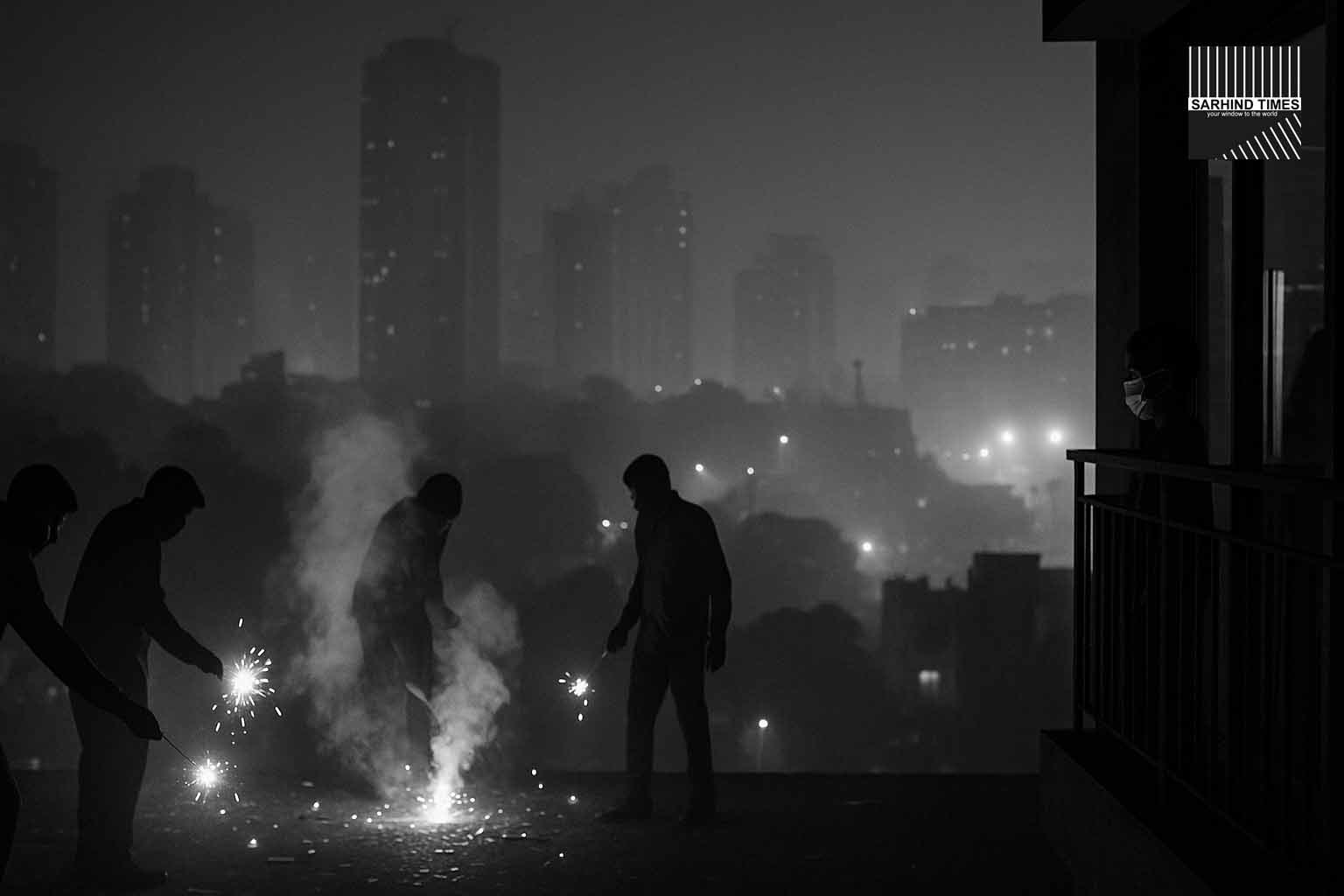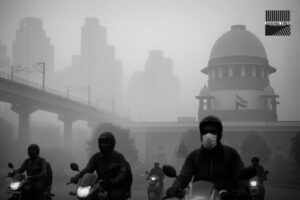Experts call for behavior change, strict enforcement, and real-time monitoring as festive season nears
(By Sarhind Times Environment Bureau | Gurugram | October 17, 2025)
Gurugram — Festive Glow, Fading Air
As Diwali approaches, Gurugram’s air quality scientists and civic authorities are sounding a familiar alarm: “green crackers” are no silver bullet.
Despite years of public campaigns promoting “eco-friendly” fireworks, researchers caution that the city’s air-shed chemistry and crowd behavior negate much of their theoretical benefit. In simpler terms, a 30% cleaner cracker does little when the number of users and total volume of bursts multiply across an already polluted atmosphere.
“When millions light up together in confined air conditions, even reduced-emission crackers overwhelm dispersion,” said Dr. Nivedita Bhargava, atmospheric scientist at TERI. “It’s a matter of scale, not just chemistry.”
With the city’s Air Quality Index (AQI) already hovering near the ‘very poor’ threshold, the onset of festival emissions could tip Gurugram toward severe smog conditions unless weather and compliance align favorably.
The Science: Why “Less Polluting” Doesn’t Mean “Clean”
Introduced in 2018 after Supreme Court interventions, “green crackers” were designed to cut particulate and gaseous emissions—not eliminate them.
These crackers, developed by the Council of Scientific and Industrial Research (CSIR), claim to:
- Reduce PM2.5 and PM10 emissions by 25–35%.
- Eliminate barium and other heavy metals.
- Lower sound intensity below 125 decibels.
However, real-world results tell a different story. Atmospheric modeling by IIT Delhi and NEERI shows that when total cracker use remains unchanged, the net ambient PM2.5 load can still rise 300–500 µg/m³ overnight, enough to push AQI into the “severe” zone.
“The physics of the atmosphere doesn’t negotiate,” explained Dr. Rakesh Verma, air-quality researcher with the National Clean Air Mission. “The same inversion layer that traps vehicle emissions also traps cracker smoke. So even cleaner fireworks accumulate rapidly.”
Gurugram’s Context: Pollution Piled High
This year, the Haryana State Pollution Control Board (HSPCB) recorded early-season AQI spikes in Sectors 45, 51, and Gwal Pahari, with particulate levels already double the national safe limit.
Add to this the backdrop of:
- Construction dust and stagnant winds.
- Crop-residue burning from nearby districts.
- High traffic density in festive shopping zones.
and even a small increase in emissions can sharply degrade local air.
“We are entering the season at a disadvantage,” admitted District Environment Officer Neha Singh. “The atmosphere is already saturated. Crackers could simply accelerate the collapse.”
Behavior and Enforcement: The Missing Links
The effectiveness of green crackers depends entirely on volume control and timing — two variables that are rarely enforced rigorously.
Although authorities restrict firework sales to certified outlets and allow use only during 8–10 p.m. windows, ground realities differ. Illegal sales through roadside vendors, online deliveries, and out-of-state shipments continue unchecked.
“Enforcement is inconsistent,” said Sandeep Dahiya, coordinator, Clean Air Gurugram Collective. “A handful of raids before Diwali cannot offset the chaos on the night itself.”
According to HSPCB data, last year Gurugram registered 93 violations under the Noise and Air Pollution Act between November 7–15 — but only 28 penalties were collected, highlighting the gap between orders and outcomes.
Civic Measures in Motion
The Gurugram Police, MCG, and HSPCB have announced a joint operational plan for 2025’s festive window:
- Patrolling & Surveillance: Over 40 mobile enforcement units will monitor high-activity areas such as Sadar Bazaar, MG Road, Sector 29 Market, and DLF Phase-III.
- Hotline Support: Residents can report illegal cracker sales or open burning at 1800-180-0172 or via the Green Gurugram App.
- Vendor Licensing: Only shops certified by the Petroleum and Explosives Safety Organization (PESO) will be permitted to stock green fireworks.
- Awareness Drives: RWAs have been advised to conduct no-cracker pledge campaigns and promote community light-and-laser shows instead.
“Our goal is not punishment but prevention,” said ACP (Traffic) Harish Malik. “We are counting on citizen awareness to lead the charge.”
Health Warnings: The Unseen Cost of Celebration
Medical experts warn that even short-term exposure to cracker emissions can trigger acute respiratory distress. Common symptoms include throat irritation, wheezing, conjunctivitis, and prolonged cough.
Children, elderly citizens, and those with asthma or heart disease are at highest risk. Hospitals in Gurugram reported a 22% rise in respiratory OPD cases during the post-Diwali week in 2024.
“Even a single night of exposure at ‘severe’ levels equals smoking 20–25 cigarettes,” said Dr. Pankaj Aggarwal, pulmonologist at Artemis Hospital. “Green crackers or not, particulate matter still enters the bloodstream.”
The Haryana Health Department has advised residents to use N95/N99 masks, avoid morning walks post-festivities, and check AQI forecasts before venturing outdoors.
The Enforcement Puzzle: Between Law and Culture
The Supreme Court’s directives on fireworks are unambiguous: only green crackers approved by CSIR and PESO may be sold, and states must ensure compliance. Yet, the socio-cultural significance of fireworks often complicates enforcement.
“We can’t police every terrace or street,” admitted a senior MCG officer. “Community responsibility is more effective than force.”
Sociologists point out that the emotional symbolism of crackers—joy, light, and togetherness—makes regulation a sensitive issue.
“Festivals are collective emotional experiences,” explained Prof. Ritu Verma, sociologist at Delhi University. “Policy succeeds only when it appeals to pride in civic behavior, not fear of fines.”
Citizen Response: Mixed but Shifting
In residential colonies like DLF Phase 4, Palam Vihar, and Sushant Lok, resident welfare associations (RWAs) have begun replacing fireworks with community light shows.
“We now organize laser displays and children’s rangoli competitions,” said RWA head Kavita Taneja. “It’s quieter, cleaner, and still festive.”
Others, however, remain unconvinced.
“If the government allows sales, why stop people from using them?” asked Vikas Chauhan, shopkeeper in Sadar Bazaar. “Let them fix supply, not blame demand.”
This tug-of-war between regulation and tradition continues to define NCR’s annual pollution crisis.
The Numbers Behind “Green”
A comparative study by the Indian Institute of Science (IISc) found:
| Type | PM2.5 Emission Reduction | SO₂ Reduction | Sound (dB) | Residue Content |
| Conventional Crackers | — | — | 160 | High |
| Green Crackers (CSIR-PESO) | 25–35% | 40% | 120–125 | Moderate |
| Real-World Mixed Use | <10% overall reduction | <15% | Variable | High (due to volume) |
The takeaway: marginally cleaner technology cannot offset behavioral non-compliance or mass-scale ignition.
Environmentalists Demand a Policy Rethink
Groups such as Fridays for Future Haryana and Warriors for Clean Air NCR have urged a temporary moratorium on all fireworks until AQI stabilizes below 150.
“This isn’t anti-celebration; it’s pro-survival,” said campaigner Shruti Sharma. “We’re not asking people to stop celebrating, just to stop suffocating.”
Their petition before the National Green Tribunal (NGT) calls for mandatory community-based celebration zones and financial penalties for repeat offenders.
Alternatives Lighting Up
Urban planners and event organizers are increasingly exploring sustainable celebrations:
- Laser & Drone Light Shows: NCR cities including Gurugram and Noida plan synchronized light performances as eco-friendly Diwali events.
- Eco Lamps & Organic Diyas: Retailers promote biodegradable earthen lamps over plastic-wrapped LED kits.
- Community ‘Green Melas’: Markets offering local handicrafts, zero-waste packaging, and live art replace firework bazaars.
“Visual grandeur need not come with particulate fallout,” said lighting designer Rajeev Saini, who is staging a 3D projection show at CyberHub this Diwali. “Technology now makes beauty clean.”
Comparative Insights: What Other Cities Are Doing
| City | Policy Measure | Results (2024) |
| Delhi | Blanket cracker ban with drone surveillance | AQI improved 18% post-Diwali vs 2023 |
| Mumbai | Restricted zones & community fireworks | Moderate compliance; AQI peaked at 265 |
| Bengaluru | Citizen-led awareness & school pledges | Firecracker sales dropped 27% |
| Gurugram | Green-cracker regulation + partial ban | AQI spike still reached ‘severe’ (post-Diwali 2024) |
The lesson: enforcement backed by public participation, not just bans, delivers meaningful results.
The Psychology of Change
Behavioral scientists studying air pollution compliance note that social cues play a stronger role than fines in curbing pollution.
“People comply when they see peers act responsibly,” said Dr. Namrata Kaur, environmental psychologist. “If RWAs and schools normalize cracker-free celebrations, others will follow.”
Campaigns like #MyAirMyFestival on Instagram, led by school students and local influencers, are gaining traction among urban youth—redefining celebration as a statement of civic pride.
Forecast: Weather Will Decide the Extent of Damage
The India Meteorological Department (IMD) predicts light northwesterly winds and falling temperatures over the weekend—conditions conducive to smog formation.
If night-time dispersion weakens, particulate levels could double overnight, pushing AQI into the 350–400 range in core city sectors.
“Even one still night after mass firework activity can undo a week of progress,” warned IMD scientist Rajesh Srivastava.
Authorities may activate GRAP Stage-2 restrictions if conditions worsen post-Diwali.
Conclusion: Beyond Fireworks, Toward Awareness
The message from scientists and civic planners is unequivocal: green crackers are a technological fix, not a solution. Air quality depends less on chemical reformulation and more on behavioral restraint and collective accountability.
As Gurugram prepares for its luminous festivities, the city faces a choice between two lights — one that sparkles briefly in the sky, and one that sustains life on earth.
#Gurugram #GreenCrackers #AirQuality #FestivalSeason #Environment #PublicHealth #NCR #Diwali #CleanAir #ClimateAction #Sustainability





















+ There are no comments
Add yours